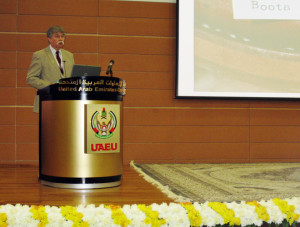Presentation to the Abu Dhabi Police Crime Laboratory

Skip Palenik lecture to the Abu Dhabi Police Laboratory
Palenik, S. (2013) Modern Trace Evidence Analysis and its Application to the Forensic Study of Soil, Sand and Dust. Conference on Forensic Geology (Abu Dhabi Police Crime Laboratory, United Arab Emirates) . Presented in November, 2013. The coloration of modern architectural paints is achieved through the addition of specific ratios of tinting pigments. This presentation discusses the major tinting pigments used in modern architectural paints in the context of forensic paint evidence. Tinting pigments are introduced as viscous colored liquids through manual or automated aliquots of specific volume to a white base paint to achieve specific custom colors. Although coloration pigments are typically present at low levels, they can be recognized through examination by polarized light microscopy (PLM) and identified through a combination of microanalytical methods. The most applicable technique for any given paint is dependant upon the actual pigments in a given sample. Therefore, a thoughtful (i.e., scientific) approach to pigment identification that is modified to fit the sample at hand is critical to the evaluation of pigment evidence. To cover a wide range of color space, manufacturers have developed a set of 12 “universal” tinting pigments. This set of 12 pigments is compatible with oil and water based paints produced by most major paint manufacturers. The universal tinting pigments include the nominally described colors: black, white, green, blue, red, magenta, yellow (3 shades), and brown (3). At least one manufacturer uses its own set of 12 tinting pigments. This manufacturer-specific set substitutes gray and orange shades in place of a brown and yellow. Three sets of universal and one set manufacturer-specific tinting pigments have been acquired from various home improvement stores. The pigments and fillers present in these densely colored solutions have been isolated through a series of sonicated acetone washes. The dried solids were prepared for analysis by a variety of microanalytical techniques for the purpose of characterizing the solid contents of these tinting solutions. The techniques used to study the isolated solids in this work include PLM, Raman microspectroscopy (RMP), energy dispersive X-ray spectroscopy (EDS), fluorescence microscopy, visible microspectrophotometry, and X-ray diffraction (XRD). Although XRD is not a microanalytical technique, it is helpful in establishing the initial identification of fillers used in the tinting pigments. Similarly, without extensive sample preparation, EDS generally does not provide a way to look directly at individual pigments in paints; however, the bulk elemental composition can provide evidence as to the major pigments in use. The architectural tinting pigments studied contain a range of inorganic and organic pigments. The black tinting colors use carbon black, while the whites use rutile (TiO2). In general, one yellow and all brown pigments are based around the iron oxides goethite (FeOOH) and hematite (Fe2O3). Copper phthalocyanines are used as the blues (PB 15 – chlorinated) and green (PG 7 – brominated/chlorinated). The red, orange, magenta and yellow (2) are based around other organic pigments. In addition, all of the tinting pigments contain significant amounts of inorganic fillers such as talc, calcite and other silicates. Using the aforementioned analytical techniques, some tinting pigments can be distinguished by manufacturer. This talk discusses the results of our research into the background of these architectural tinting pigment sets, the results of our anlaysis and applications of this information to forensic paint analysis.
How May We Help You?
Contact usto discuss your project in more detail.







